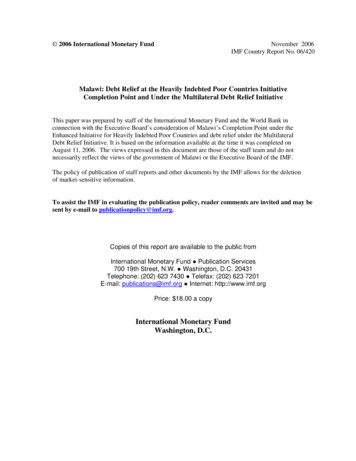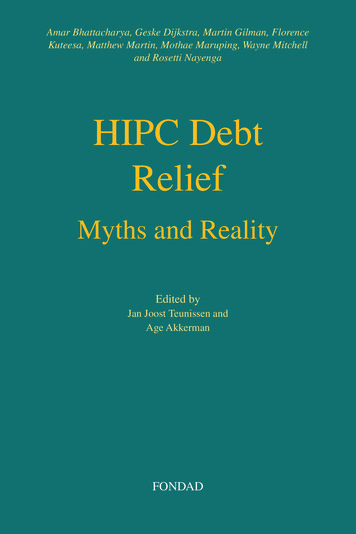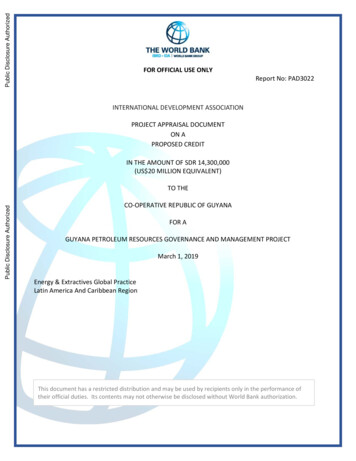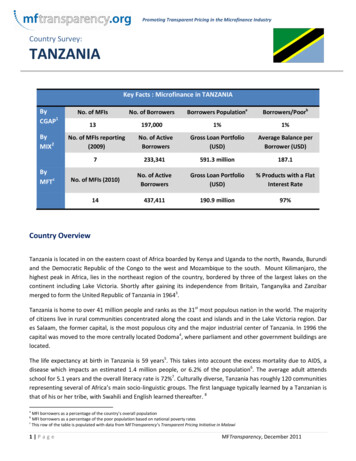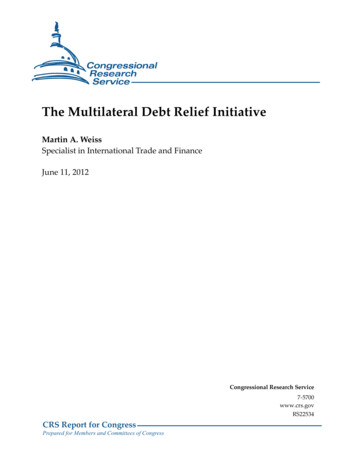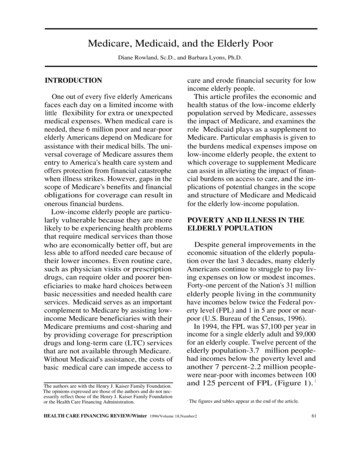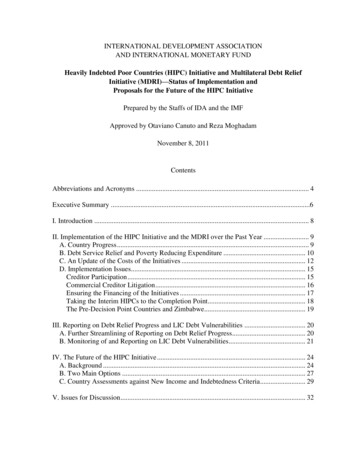
Transcription
INTERNATIONAL DEVELOPMENT ASSOCIATIONAND INTERNATIONAL MONETARY FUNDHeavily Indebted Poor Countries (HIPC) Initiative and Multilateral Debt ReliefInitiative (MDRI)—Status of Implementation andProposals for the Future of the HIPC InitiativePrepared by the Staffs of IDA and the IMFApproved by Otaviano Canuto and Reza MoghadamNovember 8, 2011ContentsAbbreviations and Acronyms . 4Executive Summary .6I. Introduction . 8II. Implementation of the HIPC Initiative and the MDRI over the Past Year . 9A. Country Progress . 9B. Debt Service Relief and Poverty Reducing Expenditure . 10C. An Update of the Costs of the Initiatives . 12D. Implementation Issues. 15Creditor Participation . 15Commercial Creditor Litigation . 16Ensuring the Financing of the Initiatives . 17Taking the Interim HIPCs to the Completion Point. 18The Pre-Decision Point Countries and Zimbabwe. 19III. Reporting on Debt Relief Progress and LIC Debt Vulnerabilities . 20A. Further Streamlining of Reporting on Debt Relief Progress. 20B. Monitoring of and Reporting on LIC Debt Vulnerabilities. 21IV. The Future of the HIPC Initiative . 24A. Background . 24B. Two Main Options . 27C. Country Assessments against New Income and Indebtedness Criteria. 29V. Issues for Discussion . 32
2Tables1. List of Heavily Indebted Poor Countries (as of end-July 2011) .92. HIPC Initiative: Costs by Main Creditor and Country Group .133. MDRI: Nominal Costs by Creditor and Country Group .144. LICs at High Risk of Debt Distress, or in Debt Distress, September 2011 .235. Status of HIPC Initiative Implementation and Ring-Fencing at End-2006 .25Figures1. Post-Decision-Point HIPCs’ Debt Stock at Different Debt Relief Stages .102. Average Poverty Reducing Expenditure and Debt Service in HIPCs .113. Distribution of Debt Distress Ratings, .22Boxes1. The Sunset Clause and the 2006 Ring-Fencing Exercise .262. Remittances in the Context of the HIPC Initiative .30AnnexesI. Assessing Remaining HIPCs against the Indebtedness Criterion at end-2010 .33II. HIPC Initiative—Methodological Aspects Related to Determining .36III. Country Status under the Enhanced HIPC Initiative .38IV. Country Coverage, Data Sources, and Assumptions for the HIPC Initiative andMDRI Costing Exercise .44Appendix Tables1. Summary of Debt Service and Poverty Reducing Expenditures 2001–2015 .462. Debt Service of 36 Post-Decision-Point HIPCs, 2001–2015.473. Poverty-Reducing Expenditure of 36 Post-Decision-Point HIPCs 2001–2015 .504. HIPC Initiative and MDRI: Committed Debt Relief and Outlook .535. HIPC Initiative: Cost Estimates to Multilateral Creditors and Status of theirCommitments and Delivery to Post-Completion-Point HIPCs .546A. Status of Delivery of HIPC Initiative and MDRI Assistance by the World Bank .556B. World Bank Group Debt Service after HIPC Initiative and MDRIDebt Relief, 2000–2015 .567A. Implementation of the HIPC Initiative and MDRI by the IMF .587B. IMF HIPC Initiative and MDRI Debt Relief, 1998–2011 .598A. Status of Delivery of HIPC Initiative and MDRI Assistance by theAfrican Development Bank (AfDB) Group .608B. AfDB Group Debt Service after HIPC Initiative and MDRIDebt Relief, 2000–2015 .619. Status of Delivery of HIPC and IaDB-07 Initiatives Assistance by theInter-American Development Bank (IaDB).6310. Status of Donor Pledges to the Debt Relief Trust Fund.64
311. HIPC Initiative: Cost Estimates to Paris Club Official Bilateral Creditorsby Creditor Country .6512. Debt Relief Committed and Delivered by the Paris Club OfficialBilateral Creditors .6613. Paris Club Official Bilateral Creditors’ Delivery of Debt Relief underBilateral Initiatives beyond the HIPC Initiative.6714. HIPC Initiative: Cost Estimates to Non-Paris Club Official BilateralCreditors by Creditor Country .6815. Debt Relief Committed and Delivered by the Non-Paris Club OfficialBilateral Creditors to the 32 Post-Completion-Point HIPCs .7016. Commercial Creditor Lawsuits agains HIPCs .71
4ABBREVIATIONS AND DRCDRFDSADSFEADBEBIDECFEFFEIBEPCAESFEUFDIAfrican Development BankAfrican Development FundArab Fund for Social and Economic DevelopmentAfrica Regional Technical Assistance CentersArab Monetary FundAsian Development BankArab Bank for Economic Development in AfricaCentral Bank of West African StatesBanque de Développement des États de l’Afrique Centrale(Central African States Development Bank)Banque de Développement des Etats des Grand Lacs(Development Bank of Great Lake States)Banque des Etats de l’Afrique Centrale (Bank of Central African States)Banque Ouest Africaine de Developpement (West African DevelopmentBank)Central American Bank for Economic IntegrationCorporación Andina de FomentoCaribbean Development BankCentro de Estudios Monetarios LatinoamericanosCommercial Interest Reference RateCARICOM Multilateral Clearing FacilityCountry Policy and Institutional AssessmentCompletion-PointDebt Management Performance AssessmentDecision-PointDemocratic Republic of the CongoDebt Reduction FacilityDebt Sustainability AnalysisDebt Sustainability FrameworkEast African Development BankECOWAS Bank for Investment and DevelopmentExtended Credit FacilityExtended Fund FacilityEuropean Investment BankEmergency Post-Conflict AssistanceExogenous Shocks FacilityEuropean UnionForeign Direct Investment
5Fonds d’Entraide et de Garantie des Emprunts du Conseil de l’Entente(Fund of Aid and of Loans Guarantee of the Agreement Council)FOCEMFondo Centroamericano de Estabilización MonetariaFONPLATA Fund for the Financial Development of the River Plate BasinFSIDFonds de solidarité islamique pour le développement(Islamic Fund for Solidarity and Economic Development)GDPGross Domestic ProductHIPCHeavily Indebted Poor CountriesIaDBInter-American Development BankIBRDInternational Bank for Reconstruction and DevelopmentIDAInternational Development AssociationIDA15Fifteenth Replenishment of IDAIFADInternational Fund for Agricultural DevelopmentIMFInternational Monetary FundI-PRSPInterim Poverty Reduction Strategy PaperIsDBIslamic Development BankJSANJoint Staff Advisory NoteLICsLow Income CountriesMDBMultilateral Development BankMDGsMillennium Development GoalsMDRIMultilateral Debt Relief InitiativeMEFMIMacroeconomic and Financial Management Institute for Eastern andSouthern AfricaMTDSMedium-Term Debt Management StrategyNDFNordic Development FundNIBNordic Investment BankODAOfficial Development AssistanceOECDOrganization for Economic Co-operation and DevelopmentOPECOrganization of Petroleum Exporting CountriesOFIDOPEC Fund for International DevelopmentPRGFPoverty Reduction and Growth FacilityPRSPPoverty Reduction Strategy PaperPTAEastern and Southern African Trade and Development BankPVPresent ValueSDRSpecial Drawing RightsSMPStaff Monitored ProgramUNCTADUnited Nations Conference on Trade and DevelopmentWAEMUWest African Economic and Monetary UnionWAIFEMWest African Institute for Financial and Economic ManagementWEOWorld Economic OutlookFEGECE
6EXECUTIVE SUMMARYThis report aims to accomplish three objectives: (a) it provides an update on the status ofimplementation, impact, and costs of the Heavily Indebted Poor Country (HIPC) Initiativeand the Multilateral Debt Relief Initiative (MDRI); (b) it proposes a modification of thereporting of progress under the initiatives, including the discontinuation of the annual statusof implementation reports, and the preparation of periodic reports on debt vulnerabilities inlow income countries (LICs), including HIPCs; and (c) it proposes a further ring-fencing ofthe list of countries eligible or potentially eligible for debt relief under the HIPC Initiativebased on end-2010 income and indebtedness criteria.Although some challenges remain, the objectives of the HIPC Initiative have largely beenreached: As a result of progress in the last few years, 36 out of 40 HIPCs have reached thedecision point, and 32 have reached the completion point and also benefited fromdebt relief under the MDRI, the last two, Guinea-Bissau and Togo, in December2010. Of the four countries between the decision and completion points (―interimHIPCs‖)—Comoros, Cote d’Ivoire and Guinea are expected to reach their respectivecompletion points within the next 15 months, while prospects for Chad remainuncertain. Only three potentially eligible countries—Eritrea, Somalia and Sudan—are yet tostart the process of qualifying for debt relief under the Initiative (i.e., they are predecision point countries). Four additional countries remain potentially eligible for HIPC debt relief. For Bhutan,Lao PDR and Nepal, their governments have indicated that they did not wish to availthemselves of HIPC Initiative assistance. While the government of the KyrgyzRepublic has not fully clarified its willingness to avail itself of debt relief under theinitiatives, its external debt burden is assessed to be well below the HIPCqualification thresholds.Some issues require continued attention in order to implement the initiatives fully: Some of the seven countries that have not yet reached the completion point and,particularly the pre-decision-point HIPCs, face especially difficult challenges.Overcoming these challenges will require sustained domestic efforts and continuedsupport from the international community. Full participation of all creditors, particularly a number of smaller multilateral, nonParis Club bilateral, and private creditors, remains to be secured.
7 Additional funds will be needed to provide debt relief to the few HIPCs havingprotracted arrears to international financial institutions. The incidence of litigation against HIPCs, albeit diminished in recent years, can becostly for HIPCs. National and multilateral initiatives have sought to respond to therisks associated with creditor litigation. In addition, by helping settle commercialcreditors’ claims on HIPCs, the IDA-managed Debt Reduction Facility (DRF) hasalso helped reduce the risk of litigation.While recognizing the need to continue monitoring the implementation of the initiatives, IMFand IDA staffs propose further streamlining HIPC Initiative and MDRI progress reporting,with updated information regularly posted on the IMF and World Banks websites rather thanin an annual status of implementation report. While there are few indications of a significantintensification of debt vulnerabilities among LICs over the last 18 months, one-third of LICsand one-quarter of HIPCs face high debt vulnerabilities. To monitor the development of debtvulnerabilities in LICs, the staffs propose the preparation of periodic joint IMF-World Bankreports on debt vulnerabilities in LICs, including HIPCs.The HIPC Initiative was not intended to be a permanent mechanism to relieve the externaldebts of LICs and the Initiative was effectively closed to new entrants in 2006 when thesunset clause was allowed to take effect and the list of potentially eligible HIPCs was ringfenced.As the HIPC Initiative has largely achieved its objectives, now is an opportune time for theIMF and IDA Executive Boards to consider options for its future. At informal sessions of theBoards in late February and early March, two options for the future of the HIPC Initiativeappeared to have the most support: (i) maintaining the Initiative as it is; and (ii) modifyingthe framework by adding end-2010 income and indebtedness criteria for eligibility andfurther ring-fencing potentially eligible countries.Under the latter option, three countries—Bhutan, the Kyrgyz Republic, and Lao PDR—would not meet the indebtedness criterion at end-2010, while four—Eritrea, Nepal, Somalia,and Sudan—would. This option, which IMF and IDA staffs propose be implemented, wouldreduce moral hazard. With the exception of Nepal, it would also be aligned with the wishesof countries whose governments have indicated that they do not wish to avail themselves ofdebt relief under the initiatives.
8I. INTRODUCTION11.This report provides an update on the status of implementation of the HIPCInitiative and the MDRI over the past year and presents proposals for the future of theHIPC Initiative. Although some challenges remain, the HIPC Initiative has been largelycompleted. As a result of progress in the last few years, 36 out of 40 HIPCs have reached thedecision point, and 32 HIPCs have reached the completion point and also benefited from debtrelief under the MDRI. Three of the four interim HIPCs are making progress toward thecompletion point. Only four potentially eligible countries are yet to start the process ofqualifying for debt relief under the Initiative. At informal sessions in late February and earlyMarch 2011, the Executive Boards of the IMF and IDA agreed that, in view of the substantialprogress that has been achieved under the HIPC Initiative to date, this was an opportune timeto consider the future of the Initiative.2 They asked the staffs to prepare specific proposals forpresentation in the next report on the status of implementation of the HIPC Initiative and theMDRI. At these informal sessions, the Boards also discussed changes to the reporting ofprogress under the initiatives, including discontinuing the status of implementation report inits current form.2.The report is organized as follows: Section II reports on progress under theinitiatives since the publication of the 2010 report.3 It also updates estimates of the benefitsand costs of the initiatives and reviews progress in enhancing creditor participation,addressing commercial creditor litigation, and securing the financing of the initiatives. Asthis is intended to be the last status of implementation report, Section III makes proposals onhow reporting of future developments under the initiatives would be handled and proposesthe introduction of periodic reports to monitor debt vulnerabilities in LICs, including HIPCs.Section IV reviews options for the future of the HIPC Initiative and, in light of the earlierinformal Board discussions, recommends the inclusion of end-2010 income and indebtednesscriteria for potential eligibility under the Initiative. Section IV also reviews the assessment of1This paper was prepared by Birgir Arnason, Brett Rayner, Yan Sun-Wang, and Malina Savova under thesupervision of Dominique Desruelle (IMF), and by Luca Bandiera and Signe Zeikate (WB).2When the IMF Board decided in 2006 to allow the sunset clause to take effect, it asked the staff ―to conduct astock-taking exercise in a few years time with a view to reviewing the options for the remaining duration of theHIPC Initiative‖. While the IDA Board took the same decision, it did not request a similar future review ofoptions for the remaining duration of the Initiative, but the President of IDA recommended that ExecutiveDirectors of IDA would consider an exit strategy for countries that have expressed the intent not to availthemselves of HIPC Initiative debt relief (see ―Heavily Indebted Poor Countries (HIPC) Initiative—IssuesRelated to the Sunset Clause,‖ August 16, 2006. A number of Executive Directors of IDA also supported astock-taking exercise to reassess the duration of the Initiative and eventually closing it.3―Heavily Indebted Poor Countries (HIPC) Initiative and Multilateral Debt Relief Initiative (MDRI) – Status ofImplementation,‖ September 14, 2010.
9potential eligibility of remaining HIPCs based on new end-2010 income and indebtednesscriteria. Section V presents issues for discussion.II. IMPLEMENTATION OF THE HIPC INITIATIVE AND THE MDRI OVER THE PAST YEARA. Country Progress3.Further progress has been made under the HIPC Initiative over the past year.Guinea-Bissau and Togo both reached their completion points in December 2010 andqualified for irrevocable debt relief.4 Of 40 HIPCs,5 32 have now reached the completionpoint and another four the decision point (Table 1).Table 1. List of Heavily Indebted Poor Countries(As of end-July 2011)1/Comoros32 Post-Completion-Point HIPCsCongo, Rep. ofLiberiaEthiopiaMadagascarGambia, ambiqueHaitiNicaraguaHondurasNiger2/4 Interim HIPCsChadCôte d’IvoireEritrea4 Pre-Decision-Point HIPCs4/SomaliaKyrgyz RepublicAfghanistanBeninBoliviaBurkina FasoBurundiCameroonCentral African RepublicCongo, Dem. Rep. of theRwandaSão Tomé and PríncipeSenegalSierra LeoneTanzaniaTogoUgandaZambiaGuinea3/Sudan1/ Countries that have qualified for irrevocable debt relief under the HIPC Initiative.2/ Countries that have qualified for assistance under the HIPC Initiative (i.e., reached decision point), but havenot yet reached completion point.3/ Countries that are eligible or potentially eligible and may wish to avail themselves of the HIPC Initiative orMDRI.4/ The Kyrgyz authorities indicated in early 2007 that they did not wish to avail themselves of debt relief underthe HIPC Initiative but subsequently expressed interest in the MDRI. This table does not list those countriesthat indicated that they did not wish to avail themselves of assistance under the Initiative, either at the time ofthe 2006 ring-fencing (Bhutan and Lao PDR) or later (Nepal).4As an indication of the continued use of the flexibility available under the HIPC Initiative, Guinea-Bissau wasgranted a waiver for a missed trigger, on the basis that the trigger had been substantially implemented andsufficient progress had been made toward the underlying objectives.5In this report, the term ―HIPCs‖ refers to all countries that have received debt relief under the HIPC Initiativeor remain eligible or potentially eligible for such debt relief.
10B. Debt Service Relief and Poverty Reducing Expenditure4.Debt relief under the HIPC Initiative and the MDRI has substantially loweredthe debt burdens of HIPCs. Debt relief under the initiatives to the 36 post-decision pointHIPCs represents almost 35 percent of these countries’ 2010 GDP. 6 Together with debtrelief under traditional mechanisms and additional (―beyond HIPC‖) relief from Paris Clubcreditors, this assistance is estimated to reduce the debt burden for these countries by about90 percent relative to pre-decision point levels (Figure 1).Figure 1. Post-Decision-Point HIPCs’ Debt Stock at Different Debt Relief Stages(In billions of U.S. dollars, in end-2010 PV 5.02035.110.34.80Before traditionaldebt reliefAfter traditional debt After HIPC Initiative After additionalreliefdebt reliefbilateral debt relief4 Interim CountriesAfter MDRI32 Completion-Point CountriesSource: World Bank and IMF staff estimates.6Debt relief committed under the Initiatives amounts to around US 128 billion in nominal terms, of whichabout US 51 billion are under the MDRI (including projected assistance under the MDRI to current interimHIPCs).
115.In parallel to the delivery of debt relief, HIPCs have increased their povertyreducing expenditure. For the 36 post-decision point countries, poverty reducing spendingincreased by more than three percentage points of GDP, on average, between 2001 and 2010,while debt service payments declined by a somewhat smaller amount (Figure 2 and Annex IIITable 1). Notwithstanding these developments, HIPCs have made uneven, and in some caseslimited, progress toward achieving the MDGs. For most of the 32 completion point HIPCsuniversal primary education is within reach, but half of them still have to implementadditional reforms in order to achieve this target. More than half of completion point HIPCsare expected to meet their targets with respect to gender equality and preventing the spread ofHIV/AIDS, TBC and malaria, and about half of them are on track to reduce under-fivemortality rates and ensure environmental sustainability. However, only a quarter ofcompletion point HIPCs are on track to meeting MDG 1 (to eradicate extreme poverty andhunger), with progress toward MDG 6 (to improve maternal health) less certain. Only a fewHIPCs are on track to meet MDG 8 (to build a global partnership for development) (AnnexIII Table 3).Figure 2. Average Poverty Reducing Expenditure and Debt Service in HIPCs 1/1412Poverty reducingexpenditurePercent of GDP108642Debt : HIPC documents and IMF staff estimates1/ For detailed country data and projections, refer to Appendix Table 2 and Table 3.2015p
12C. An Update of the Costs of the Initiatives6.The total cost of HIPC Initiative debt relief to creditors is estimated atUS 76 billion in end-2010 present value (PV) terms (Table 2). The estimated costs arebroadly unchanged relative to 2010 estimates. Changes reflect small revisions of data for thetwo new completion point countries and a lower discount rate.7 About two-thirds of the cost(US 54.6 billion) represents irrevocable debt relief to the 32 post-completion point countries.The estimated cost for the four interim countries amounts to US 4.4 billion.8 The estimatedcost of HIPC Initiative debt relief to the creditors of the remaining four pre-decision pointHIPCs is estimated at US 17 billion, most of which is accounted for by two countries, Sudanand Somalia. Topping-up assistance, which has been provided so far to seven HIPCs,represents less than 3 percent of the total HIPC Initiative cost.97.Multilateral and Paris Club creditors bear the largest shares of the total cost ofthe HIPC Initiative, but non-Paris Club and commercial creditors are expected toprovide a relatively larger share of debt relief for pre-decision point HIPCs. Amongmultilateral creditors (accounting for 45 percent of the total cost), the heaviest burdens areborne by IDA (20 percent), the IMF (9 percent), and the AfDB group (7 percent). The shareof the total cost borne by multilateral creditors is higher for post-completion point countries(50 percent) than for interim countries (35 percent) and pre-decision point countries(31 percent). Bilateral creditors account for over half of the total cost of the HIPC Initiative,most of which is borne by Paris Club creditors (36 percent). Non-Paris Club official creditorsand commercial creditors account for 13 percent and 6 percent, respectively. However, nonParis Club creditors are expected to deliver about 30 percent of HIPC Initiative assistance topre-decision point HIPCs. Hence, only broad participation of creditors would ensure theeffective delivery of HIPC Initiative debt relief in those cases.8.The total cost of the MDRI for the four participating multilateral creditors isestimated at US 33.8 billion in end-2010 PV terms (Table 3). About 65 percent of the totalestimated MDRI cost will be borne by IDA, with the share of the IMF and AfDF amountingto 12 percent and 15 percent, respectively, and that of the IaDB amounting to 8 percent. Outof the total cost, US 30.3 billion in PV terms has already been delivered to the 32 post7See Annex IV for assumptions on the discount rate used to calculate the PV of debt relief under the HIPCInitiative and the MDRI.8The shift in cost (from interim countries to completion point countries) compared to last year is the result ofTogo and Guinea Bissau reaching their completion points.9If a country’s debt burden indicators deteriorate substantially due to exogenous factors that fundamentallyaffect the country’s economic circumstances, it may receive additional HIPC assistance (topping-up) atcompletion point. Countries that have received topping-up assistance include Burkina Faso, Guinea-Bissau,Ethiopia, Malawi, Niger, Rwanda, and São Tomé and Príncipe.
13completion-point countries. The IMF has also provided MDRI relief to Cambodia andTajikistan (Table 3 and Appendix Table 4).Table 2. HIPC Initiative: Costs by Main Creditor and Country Group(In billions of U.S. dollars, in end-2010 PV terms, unless otherwise indicated)32Post-CompletionPoint HIPCs(32)InterimHIPCs(4)Total Post-DecisionPoint HIPCs(36)Pre-DecisionPoint HIPCs(4)1Total(I)(II)(III) (I) (II)(IV)(V) (III) (IV)Multilateral creditorsIDAIMFAfDB 55.51.75.4Bilateral and commercial creditorsParis ClubOther Official 1.85.13.511.65.84.91.042.027.69.94.6Total Costs54.64.459.017.076.0Memorandum ItemsTotal Costs from Previous Report 1/53.55.358.917.075.9Total Change in Costs (percent)- due to countries’ progress through the HIPC Initiative 2/- due to data .20.20.0(40)Sources: Country authorities, and World Bank and IMF staff estimates.1/ Total costs as reported in Table 2 of "HIPC Initiative and MDRI: Status of Implementation, September 2010", discounted to end-2010 terms.2/ Since August 2010, Togo and Guinea-Bissau reached the completion point.9.Some creditors have given debt relief to HIPCs that goes beyond therequirements under the HIPC Initiative. Paris Club official bilateral creditors haveprovided, on a case by case basis, beyond HIPC Initiative debt relief amounting toUS 11.9 billion in end-2010 PV terms (see Appendix Tables 12 and 13). In addition to debtrelief under the HIPC Initiative, the EU provides debt relief under the Least DevelopedCountries (LDC) Initiative by cancellation of the debt outstanding on special loans after theapplication of HIPC Initiative relief.10 Most multilateral and bilateral creditors have approvedthe cancellation of outstanding debt beyond HIPC and MDRI to help Haiti recover from theJanuary 2010 earthquake.1110Between inception and end-July 2011, EU has provided additional debt relief on special loans of eightcompletion-point and one decision-point country amounting to EUR77.4 million.11Outstanding World Bank debt of US 36 million (equivalent) owed by Haiti to IDA was canceled in May2010 using contributions out of unallocated donor investment income in the DRTF from 13 donors (Belgium,Canada, Finland, France, Germany, Ireland, Italy, Japan, The Netherlands, Norway, Spain, Sweden, andSwitzerland). On July 21, 2010, the IMF approved the provision of debt stock relief under the Post-Catastrophe(continued )
14Table 3. MDRI: Nominal Costs by Creditor and Country Group(In billions of U.S. dollars)Post-Completion-Point HIPCs 1/3333IDAIMF 3/AfDFIaDBInterim and Pre-Decision-Point HIPCs 2/2222Assistance in Nominal Terms 2/Assistance in end-2010 PVTermsPrincipalForegoneInterestTotalPrincipal and 0.91.031.43.47.74.419.53.74.22.94.80.85.63.5IDAIMF .50.70.0All HIPCs47.05.552.533.8IDAIMF .94.24.92.9N
start the process of qualifying for debt relief under the Initiative (i.e., they are pre-decision point countries). Four additional countries remain potentially eligible for HIPC debt relief. For Bhutan, Lao PDR and Nepal, their governments have indicated that they did not wish to avail themselves of HIPC Initiative assistance.
